Are you looking to streamline your hedge accounting documentation? Understanding the nuances of hedge accounting can be a challenge, but having the right letter template can simplify the process significantly. This guide will provide you with a clear framework to create effective and compliant documentation tailored to your financial needs. So, let's dive into the details and make hedge accounting easier for youâread on to learn more!

Objective and Strategy Documentation
Hedge accounting documentation requires a comprehensive objective and strategy framework to ensure compliance with International Financial Reporting Standards (IFRS) or Generally Accepted Accounting Principles (GAAP). The objective outlines the risk management goals, particularly in volatile financial environments affecting interest rates or currency exchange rates. The strategy section details the specific hedging instruments, such as interest rate swaps or foreign currency forwards, used to mitigate identified risks. Additionally, clear metrics for the effectiveness of hedges must be established, incorporating quantitative assessments and qualitative evaluations in accordance with the hedge effectiveness testing protocols. Finally, it is essential to document the periodic review processes to monitor the hedging strategy's alignment with the overall financial objectives of the organization, anchored in a specific timeframe, such as quarterly or annually, as defined by the corporation's fiscal calendar.
Risk Management Policy Alignment
Hedge accounting documentation establishes the relationship between a hedging instrument and a hedged item to manage financial risk. This documentation must align with the organization's risk management policy, which includes principles for evaluating, measuring, and managing risks related to currency fluctuations and interest rate changes. Key components should detail how the hedging strategy supports specific objectives, such as stabilizing cash flows or minimizing the impact of market volatility, particularly in exposure-heavy areas like foreign investments or variable-rate debt instruments. Clear quantification of risk exposure, documented evaluation methods, and the impact assessment of hedging effectiveness on overall financial statements are essential to ensure compliance with accounting standards like IFRS 9 or ASC 815. Regular reviews of the risk management policy and adjustments to the hedging strategy may be necessary to reflect changing market conditions or organizational objectives, emphasizing the dynamic nature of risk management.
Hedge Instrument and Hedged Item Correlation
In hedge accounting, the correlation between the hedge instrument, such as a derivative financial instrument like interest rate swaps or forward contracts, and the hedged item, typically an asset or liability like loans or forecasted transactions, is crucial for effective risk management. For instance, an interest rate swap might be used to hedge against the fluctuations in interest rates that affect a company's variable-rate debt amounting to $10 million. The effectiveness of this hedge is assessed through a statistical analysis, often using the regression method, where the correlation coefficient needs to fall between 0.80 to 1.00 to demonstrate a strong relationship. Moreover, it is essential to document the methodology used for the assessment, including specifics such as the date of analysis, the time frame covered, and the data sources applied, ensuring compliance with International Financial Reporting Standards (IFRS) or Generally Accepted Accounting Principles (GAAP). Regular reviews, typically conducted quarterly, must be documented to ensure ongoing effectiveness of the hedge strategy in relation to the financial conditions surrounding the hedged item.
Effectiveness Assessment Procedures
Effectiveness assessment procedures for hedge accounting require thorough documentation to ensure compliance with International Financial Reporting Standards (IFRS) 9. Hedging relationships must exhibit a high level of effectiveness in offsetting changes in cash flows or fair values of hedged items, such as fixed-rate loans or commodity price fluctuations. Evaluation methods include qualitative assessments, quantitative analyses, and the use of regression analysis to measure statistical correlation. The documentation should also detail the time frame of assessment, typically conducted at inception and on a regular basis (at least annually or whenever significant changes occur). Designated metrics, such as the dollar offset method, provide measurable criteria to assess effectiveness, targeting thresholds (commonly above 80% and below 125%) for qualifying hedges. Additionally, records of the hedging instruments--like interest rate swaps or forward contracts--must be maintained, including their terms, maturity dates, and underlying exposure characteristics.
Compliance with Accounting Standards
Hedge accounting is a critical financial practice that aligns the accounting treatment of hedging instruments with the underlying exposure they are intended to mitigate, such as interest rate risks, foreign currency risks, or commodity price fluctuations. Compliance with International Financial Reporting Standards (IFRS) 9 necessitates detailed documentation to demonstrate the effectiveness of hedging relationships at inception and throughout their duration. This includes a clear identification of the hedged item, such as a specific loan or forecasted transaction valued at $5 million, and the hedging instrument, possibly an interest rate swap with a notional amount of $5 million as well. The entities involved, including Bank of America or JP Morgan, must provide evidence of the risk management objectives and strategies in place, alongside methods for assessing hedge effectiveness by quantifying changes in cash flows or fair values. Thorough documentation must also address the rebalancing of hedged items and instruments in response to market fluctuations, ensuring compliance with the rigorous standards set forth by the Financial Accounting Standards Board (FASB) and the IFRS.













Comments